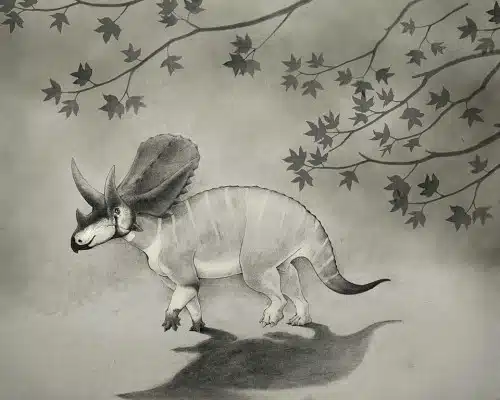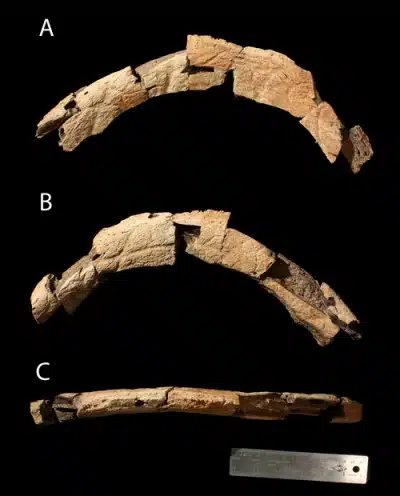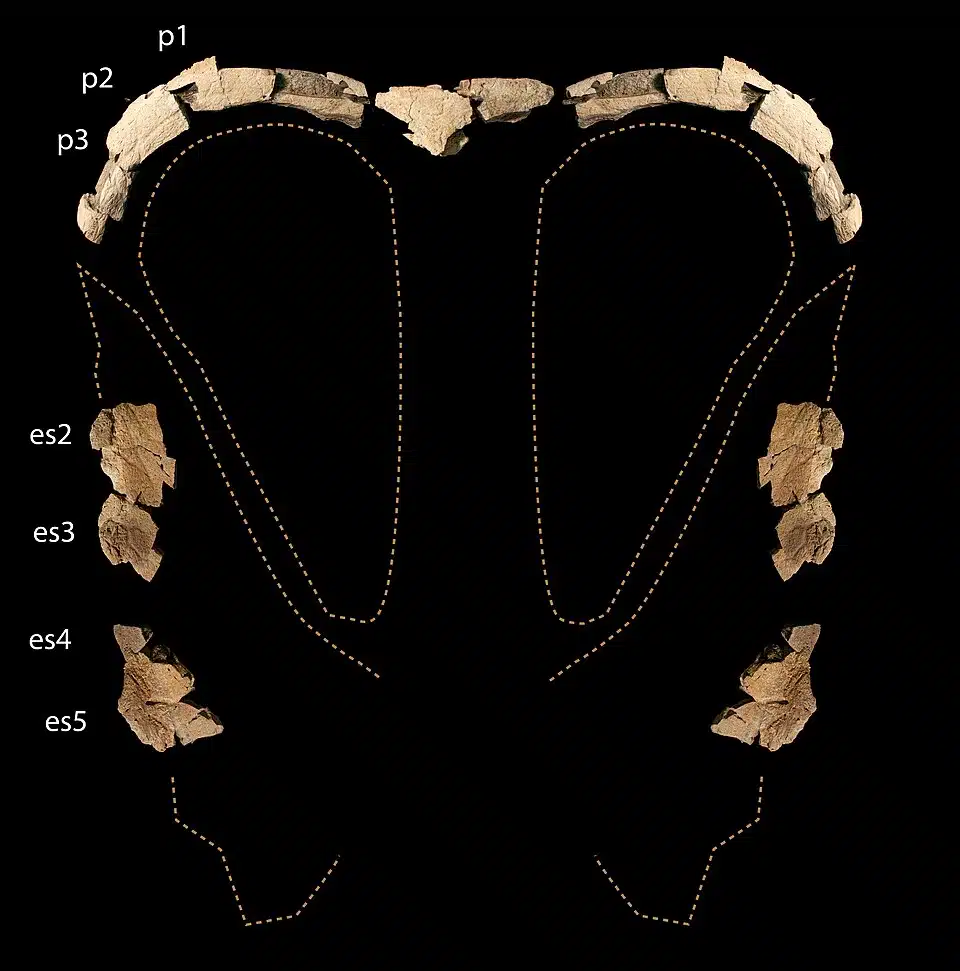In the exposed Cretaceous sediments of Montana’s Judith River Formation, paleontologists uncovered evidence of an intriguing chapter in horned dinosaur evolution. Dating to around 78 million years ago during the Middle Campanian, the fossils were dubbed Judiceratops tigris, one of the earliest known chasmosaurines. Although known only from fragmentary skull material, its distinctive frill and horn morphology set it apart as a genus of its own.
The remains of Judiceratops were first excavated in the late 1970’s and early 1980’s by Princeton University field teams. Decades later, in 2013, paleontologist Nicholas R. Longrich would formally describe and name the dinosaur. With an anatomy that blends primitive and derived characteristics, Judiceratops helps bridge evolutionary gaps in our understanding of ceratopsid diversity. It also highlights how much is still to be discovered in even well-explored fossil beds.
Judiceratops Key Facts
| Keyword | Fact |
|---|---|
| Pronunciation | JOO-dee-SAIR-uh-tops |
| Meaning of name | Judith River Horned Face |
| Group | Ceratopsia |
| Type Species | Judiceratops tigris |
| Diet | Herbivore |
| When it Lived | ~78 MYA |
| Period | Late Cretaceous |
| Epoch | Campanian |
| Length | Not specified |
| Height | Not specified |
| Weight | Not specified |
| Mobility | Moved on all four legs (quadrupedal) |
| First Discovery | Late 1970’s to early 1980’s by Princeton University crews |
| Described by | 2013 by Nicholas Longrich |
| Holotype | YPM-PU 22404 |
| Location of first find | Hill County, Montana, near the Canada–USA border |
Judiceratops Origins, Taxonomy and Timeline
The name Judiceratops draws from both location and morphology. “Judi-” refers to the Judith River Formation where it was discovered, while the suffix “-ceratops” comes from the Greek keras meaning “horn” and ops meaning “face.” The species name tigris honors the tiger mascot of Princeton University, which conducted the original field expeditions. Together, the name tells a story of place, discovery, and identity.

Taxonomically, this dinosaur belongs to Ceratopsia, the group of horned ornithischian dinosaurs, and more specifically to the family Ceratopsidae, which is divided into two major subfamilies: Chasmosaurinae and Centrosaurinae. Chasmosaurines, like Chasmosaurus and Triceratops, typically had long frills and prominent brow horns, while centrosaurines, such as Centrosaurus and Styracosaurus, tended to have shorter frills with elaborate ornamentation and more prominent nasal horns. Judiceratops tigris is firmly placed within Chasmosaurinae and represents one of its earliest known members. It is the type and only known species of its genus.
Based on radiometric dating of the surrounding sediments, this dinosaur lived approximately 78 million years ago, placing it in the early part of the Campanian Stage of the Late Cretaceous. This interval marked the beginning of a major evolutionary radiation of horned dinosaurs in North America, and Judiceratops is among the earliest known members of that diversification within the Chasmosaurinae.
Discovery & Fossil Evidence
The fossils of Judiceratops were first collected from Hill County, Montana, in an area close to the Canadian border. These remains were excavated by field crews from Princeton University during the late 1970s and early 1980s. Although the material was fragmentary and partially weathered when found, the bones were still diagnostic enough to warrant description as a new species.
The holotype, catalogued as YPM-PU 22404, includes parts of the skull such as the postorbital horns, frontals, prefrontals, squamosals, parietals, and elements of the occipital region. Additional referred specimens—such as YPM-PU 23262 and YPM-PU 23411—preserve portions of the squamosal and horncore, along with possible frill ornamentation, offering limited but valuable insights into variation in cranial morphology.
Although incomplete, these skull fragments revealed a blend of characteristics not seen in any other ceratopsid. No additional finds of Judiceratops have been confirmed outside this location, and the known material remains limited to these original Princeton collections.
- Posterior margin of the frill (parietal) of the dinosaur Judiceratops tigris
- Reconstructed frill of the holotype of Judiceratops tigris from the Judith River Formation of Montana, with pareital and squamosal elements from the right side of the frill mirrored on the left.
Judiceratops Size and Description
Short description of Judiceratops
The skull of Judiceratops featured moderately long, outward-angled postorbital (brow) horns with an ovate (egg-shaped) cross-section—distinct among known chasmosaurines. These horns tilted forward and outward, a feature shared with Mojoceratops. Its frill was broad, and the preserved portions suggest a rounded, unemarginated posterior margin, though the overall frill shape remains partially speculative due to fragmentary preservation.
The episquamosals—bony projections on the lateral frill—were broad-based and mostly uniform in size, lying flush with the frill surface as in other chasmosaurines. Although initially interpreted as forming a shingled, centrosaurine-like arrangement, a later re-examination by Campbell (2015) concluded that all preserved episquamosals were in fact aligned within the plane of the frill, consistent with typical chasmosaurine morphology.
The fused cranial and frill elements indicate a mature individual with a robust skull structure. Like other ceratopsids, it was likely a quadruped, relying on strong forelimbs to support its heavy head.
Size and Weight of Type Species
The exact body size of Judiceratops remains uncertain due to the lack of a postcranial skeleton. However, given its classification and comparisons to close relatives like Chasmosaurus, paleontologists estimate it may have measured roughly 15.0 to 18.0 feet in length.
Based on typical proportions for chasmosaurines of this age, the dino may have stood about 6.0 to 7.0 feet tall at the shoulder. Weight estimates are necessarily rough, but it likely tipped the scales at around 2.0 to 3.0 tons, assuming similar build and bone structure to its relatives.
These values position it as a mid-sized member of the horned dinosaur family—smaller than Triceratops, but still an impressive herbivore in its time.
The Dinosaur in Detail
What sets this animal apart is the unique combination of primitive and derived traits in its frill and horns. The posterior edge of the parietal is convex and rounded, lacking the deep embayments seen in many later chasmosaurines—a condition also found in more basal taxa such as Arrhinoceratops and Vagaceratops. Nonetheless, the parietal was also posteriorly expanded beyond the squamosals, contributing to a longer overall frill—a derived feature shared with taxa like Mojoceratops and Medusaceratops.

The epiparietals were low and subdued, more broad than tall, contrasting with the larger and more elaborate ornamentation in later chasmosaurines (Triceratops, Torosaurus) and centrosaurines. Along the squamosal margin, the episquamosals were uniformly broad-based and flush with the frill surface, consistent with typical chasmosaurine anatomy. The squamosal itself was elongate and triangular, resembling that of Chasmosaurus and Mojoceratops, and differing from the shorter, rectangular squamosals seen in centrosaurines.
The horns, however, are perhaps the most distinctive feature. Rather than pointing upward or curving backward, they projected forward and outward, with an ovate (egg-shaped) cross-section—an autapomorphic trait unique to Judiceratops. This configuration contrasts sharply with the more circular or subtriangular horncore bases of most other ceratopsids.
Taken together, these anatomical nuances paint a picture of an animal that straddled evolutionary boundaries—neither fully primitive nor completely derived. It represents a transitional form early in chasmosaurine history, combining ancestral traits with novel specializations that hint at the broader trajectory of horned dinosaur evolution.
Interesting Points about Judiceratops
- The only known fossils of Judiceratops come from a small area in Montana near the Canadian border and were collected more than 40 years before they were formally described.
- Its combination of an unadorned, rounded frill margin, and uniformly small, low-lying epiparietals is unique among chasmosaurine dinosaurs and helps distinguish it from all previously known species.
- Phylogenetic analysis places it near the base of the Chasmosaurinae, making it one of the oldest known members of this subfamily.
- Its brow-horn shape, featuring an ovate-like (eggshaped) cross-section and anterolaterally oriented, posteriorly curved morphology is not seen in any other known ceratopsid.
- Despite its age, it shares surprising features with both more advanced and more primitive ceratopsians, making it a mosaic of evolutionary traits.
Contemporary Dinosaurs
Roaming the Late Cretaceous landscape of what is now Montana, Judiceratops may have shared its environment with other early ceratopsians such as Diabloceratops, a slightly older relative from southern Utah. Though more primitive in its skeletal structure, Diabloceratops bore strikingly elaborate frill horns that curved upward like twisted sabers—a dramatic contrast to the more modest, forward-angled horns of Judiceratops. These differences may have helped signal species identity and reduce direct competition.
Another large herbivore on the same floodplains was Brachylophosaurus, a broad-crested hadrosaurid with a long, low-slung profile. Lacking horns or frills, it relied on size and possibly herding behavior for defense. Likely feeding at different heights or on different plant types than Judiceratops, it demonstrates how niche partitioning allowed large herbivores to coexist.
Towering above the floodplain was Daspletosaurus, a massive tyrannosaurid and the apex predator of the region. With its powerful jaws and bone-crushing bite, it likely preyed on hadrosaurs and juvenile ceratopsids, or scavenged carcasses when the opportunity arose. The presence of such a formidable carnivore would have shaped the behavior and movement of herbivorous dinosaurs like Judiceratops, perhaps encouraging group living or defensive posturing in response to predation pressure.
Beneath the forest canopy, small pachycephalosaurs like Stegoceras moved nimbly through the underbrush. Known for its thick, domed skull, this agile biped may have engaged in head-butting contests, contrasting sharply with the horned, quadrupedal Judiceratops. Yet both played distinct roles in their ecosystem, each adapted to its own way of life.
Judiceratops in its Natural Habitat
The environment where Judiceratops lived was seasonally warm and semi-humid, consisting of coastal plains, meandering rivers, and periodically flooded lowlands. These dynamic wetlands supported a diverse plant community—ferns, cycads, conifers, and early flowering plants—offering abundant food sources for herbivores.
Like other ceratopsids, Judiceratops likely used its sharp beak and battery of shearing teeth to crop tough, low-growing vegetation. Its broad muzzle suggests a non-selective grazing strategy, ideal for feeding on ground-level plants in bulk rather than picking selectively. Although there is no direct fossil evidence of predator-prey interaction, it would have shared its habitat with large theropods like Daspletosaurus, and likely relied on group vigilance or behavioral cues to avoid predation.
While social behavior remains speculative, it is possible that Judiceratops lived in small groups or loosely organized herds, as inferred from better-known ceratopsids. Individual variation in horn and frill shape may have played a role in species recognition, mate selection, or dominance displays. As a large-bodied herbivore, Judiceratops would have played an important role in structuring its ecosystem—shaping vegetation through its grazing habits and serving as a potential food source for large predators like Daspletosaurus.
Frequently Asked Questions
It was first found during fieldwork in the late 1970s and early 1980s by crews from Princeton University.
This dinosaur lived in what is now Montana, near the USA–Canada border, in the Judith River Formation.
Judiceratops was a ceratopsid, part of the horned dinosaur group, and belonged to the subfamily Chasmosaurinae.
Exact size is unknown, but estimates suggest a length of 15.0 to 18.0 feet and a weight of about 2.0 to 3.0 tons.
It was a herbivore, most likely preyed upon by large theropods of its time.
It had a rare combination of features, including outward-angled horns and a broad, rounded frill with low bony projections.
Sources
The information in this article is based on various sources, drawing on scientific research, fossil evidence, and expert analysis. The aim is to provide a comprehensive and accurate overview of Judiceratops. However, please be aware that our understanding of dinosaurs and their world is constantly evolving as new discoveries are made.
This article was last fact checked: Joey Arboleda, 05-06-2025
Featured Image Credit: Nobu Tamura, CC BY-SA 4.0, via Wikimedia Commons


